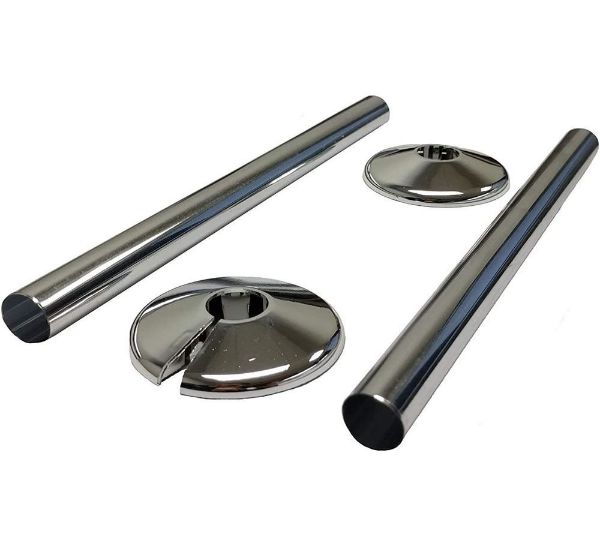Radiator pipe covers are a great way to add style and functionality to the radiator and its surrounding area. They come in various materials, shapes and sizes, so choosing the right one for your application is essential. In this guide, we’ll explore the different types of radiator pipe covers, their benefits, installation and maintenance tips, and more.
Introduction to Radiator Pipe Covers
Radiator pipe covers are a great way to give your radiator a new look and keep it in good condition. They are available in various materials, shapes and sizes, so you can easily find one that fits your needs. Radiator pipe covers are also helpful for hiding unsightly pipes and wires and providing insulation against heat loss.
Types of Radiator Pipe Covers
Radiator pipe covers come in a variety of materials, shapes and sizes. Some of the most popular radiator pipe covers include chrome, copper and plastic. Each material has advantages and disadvantages, so it’s essential to choose the right one for your application.
Chrome radiator pipe covers:
Chrome radiator pipe covers are a great way to give your radiator a sleek, modern look. Also, they are easy to clean and maintain, and they come in a variety of shapes and sizes. Chrome radiator pipe covers are also resistant to rust and corrosion, making them a great choice for areas with high humidity.
Copper pipe cover:
Copper pipe cover is another popular option for radiator pipe covers. Copper is a great insulation material, as it is an excellent conductor of heat. Copper pipe covers are durable and can last for years with proper care and maintenance.
Plastic radiator pipe covers:
These are an excellent choice for those on a budget. They are available in various colours and styles, so you can easily find one that fits your needs. Plastic radiator pipe covers are lightweight and easy to install, making them a great option for those who really want to save time and money.
Benefits of Using Radiator Pipe Covers
Radiator pipe covers are a great way to give your radiator a new look and protect it from damage. The covers are available in a variety of materials, shapes and sizes, so that you can easily find the one that fits your needs. Radiator pipe covers are also useful for hiding unsightly pipes and wires, as well as providing insulation against heat loss.
In addition to giving your radiator a new look, radiator pipe covers also provide added protection against damage. They are available in various of materials, so you can easily find one that is resistant to rust and corrosion. Radiator pipe covers also help to keep your radiator clean, as they can trap dirt and debris.
Radiator pipe covers are also a great way to add insulation to your radiator. They are available in various of materials, so you can easily find one that provides the right amount of insulation for your application. Radiator pipe covers also help to reduce heat loss, making them a great choice for areas with high humidity.
How to cover radiator pipes
Covering radiator pipes is a relatively simple process. Depending on the type of radiator pipe cover you are using, the installation process may differ slightly. Generally speaking; however, the installation process is fairly straightforward.
Before you begin, make sure that you have all the necessary materials and tools. You will need a screwdriver, a drill, a hacksaw, and the appropriate screws and bolts. It’s also a good idea to have an assistant to help you with the installation.
Once you have all the materials and tools you need, you can begin the installation process. Start by removing any existing covers from the radiator. Make sure to take note of the size and shape of the radiator pipe covers you are installing, as this will help ensure that the installation is done properly.
Next, mark the location of the radiator pipe covers on the wall. Make sure to measure twice and mark once to ensure that the covers are installed in the correct location. Once the locations have been marked, you can begin drilling the holes for the screws and bolts.
Once the holes have been drilled, you can attach the radiator pipe covers to the wall. Make sure to use the appropriate screws and bolts for the type of radiator pipe cover you are installing. Once the covers have been attached, you can plug the wires and pipes into the radiator.
Different Materials Used in Radiator Pipe Covers
Radiator pipe covers are available in various materials, so choosing the right one for your application is essential. Some of the most popular materials used in radiator pipe covers include chrome, copper and plastic. Each material has advantages and disadvantages, so it’s essential to choose the right one for your application.
Chrome radiator pipe covers are a great way to give your radiator a sleek, modern look. Also, they are easy to clean and maintain, and they come in a variety of shapes and sizes. Chrome radiator pipe covers are also resistant to rust and corrosion, making them an excellent choice for areas with high humidity.
Copper pipe cover is another popular option for radiator pipe covers. Copper is a great insulation material, as it is an excellent conductor of heat. Copper pipe covers are durable and can last for years with proper care and maintenance.
Plastic radiator pipe covers are an excellent choice for those on a budget. They are available in various colours and styles, so you can easily find one that fits your needs. Plastic radiator pipe covers are lightweight and easy to install, making them an excellent option for those who want to save time and money.
Chrome Radiator Pipe Covers
Installation of chrome radiator pipe covers is relatively simple. Start by measuring the area where the covers will be installed. Make sure to measure twice and mark once to ensure that the covers are installed in the correct location. Once the locations have been marked, you can begin drilling the holes for the screws and bolts.
Chrome radiator pipe covers are easy to clean and maintain. To keep them looking their best, it’s important to regularly dust them off and wipe them down with a damp cloth. Chrome radiator pipe covers are also resistant to rust and corrosion, so you don’t have to worry about them deteriorating over time.
Copper Pipe Cover
Installation of copper pipe covers is similar to that of chrome radiator pipe covers. Start by measuring the area where the covers will be installed. Make sure to measure twice and mark once to ensure that the covers are installed in the correct location. Once the locations have been marked, you can begin drilling the holes for the screws and bolts.
Copper pipe covers are easy to clean and maintain. To keep them looking their best, it’s important to regularly dust them off and wipe them down with a damp cloth. Copper pipe covers are also resistant to rust and corrosion, so you don’t have to worry about them deteriorating over time.
Other Types of Radiator Pipe Covers
In addition to chrome and copper, there are a variety of other materials used in radiator pipe covers. These include plastic, stainless steel and aluminium. Each material has its advantages and disadvantages, so it’s important to choose the right one for your application.
Plastic radiator pipe covers are an excellent choice for those on a budget.
They are available in various of colours and styles, so you can easily find one that fits your needs. Plastic radiator pipe covers are lightweight and easy to install, making them a great option for those who want to save time and money.
Stainless steel radiator pipe covers are a great choice for those looking for a durable, corrosion-resistant material. Stainless steel is also highly resistant to rust and corrosion, making it a great choice for areas with high humidity. Stainless steel radiator pipe covers are also easy to install and maintain.
Aluminium radiator pipe covers are an excellent choice for those looking for a lightweight material. Aluminium is also a great conductor of heat, making it a great choice for insulation. Aluminium radiator pipe covers are also easy to install and maintain.
Maintenance and Care of Radiator Pipe Covers
It’s important to regularly maintain and care for your radiator pipe covers to ensure that they last for years to come. To keep them looking their best, it’s important to regularly dust them off and wipe them down with a damp cloth. It’s also important to check for any signs of rust or corrosion, as this can cause the covers to deteriorate over time.
In addition to regular cleaning and maintenance, it’s also important to inspect the radiator pipe covers for any signs of damage. If you notice any cracks or holes, it’s important to replace the covers as soon as possible to prevent further damage.
Conclusion
Installing radiator pipe covers is a relatively simple process. Depending on the type of radiator pipe cover you are using, the installation process may differ slightly. Generally speaking; however, the installation process is fairly straightforward.
It’s also important to regularly maintain and care for your radiator pipe covers to ensure that they last for years to come. To keep them looking their best, it’s important to regularly dust them off and wipe them down with a damp cloth. It’s also important to check for any signs of rust or corrosion, as this can cause the covers to deteriorate over time.
If you’re looking for a quick and easy way to give your radiator a new look and protect it from damage, radiator pipe covers are a great option. Buy the radiator pipe covers from towelradiator.co.uk to get the best quality and value for your money.


